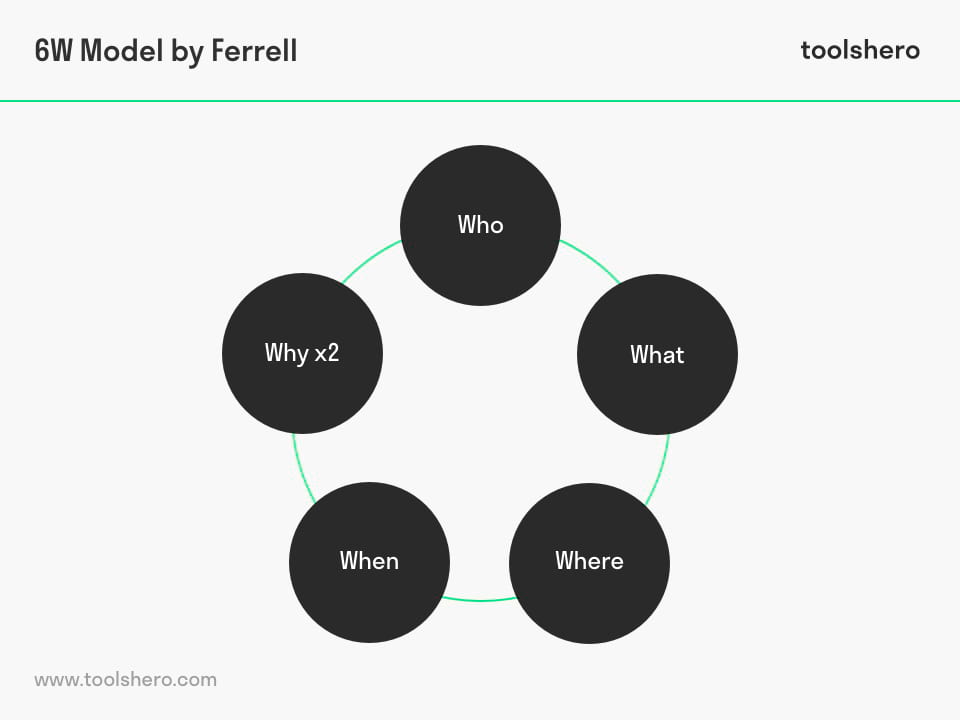6W model of Customer Analysis (Ferrell)

6W Model of Customer Analysis: this article provides a practical explanation of 6W Model of Customer Analysis. This article highlights next to 6W model, also the relationship with Market Research. After reading, you will understand the basics of this powerful marketing tool. Enjoy Reading!
What is the 6W Model of Customer Analysis?
6W Model of Customer Analysis is an external analysis and part of the CICD Analysis for analysing an organisation’s external environment.
This external analysis, that also includes the SWOT analysis, is crucial for creating a structured strategic marketing plan. The other letters of the CICD Analysis stand for: branch, competition and distribution.
6W Model of Customer Analysis is used to analyse the customers of a company. This provides insight into the wishes and needs of customers as well as categorises various customer groups. Examples of customers are manufacturers, dealers and consumers.
A customer analysis lets the user and organisation investigate potential customers of a company and their buying behaviour and product use. For this purpose, the buying behaviour of potential customers is studied.
Additionally, market research is used to investigate their wishes and needs. These can change constantly, which is why a customer analysis is a recurring activity for many companies.
The 6W model of Ferrell is used for both strategy development and marketing objectives. Generally speaking, the 6W model is used to identify threats and opportunities in the market.
The 6W Model of Customer Analysis was developed by O.C. Ferrell. The American marketing professor works at the University of New Mexico in the United States. He has gained recognition for his contributions in various fields: ethical decision making, stakeholder relationships and social responsibility.

Figure 1 – 6W Model (Ferrell)
6W Model of Customer Analysis explained by element
The behaviour of customers can be effectively analysed by answering the following six questions. The questions of the 6W model of Ferrell are general and can’t always be answered right from the start.
Therefore, it’s important that people with the right knowledge conduct a preliminary investigation and start answering the sub-questions.
1. Who are our current and potential customers?
- What are demographic characteristics of the customers?
- What are geographic characteristics of the customers?
- What are psychological characteristics of the customers?
- Who purchase our products?
- Are the customers influenced during the purchase process?
- Do the customers bear the financial responsibility for the purchases themselves?
2. What do our current and potential customers do with their products (value proposition)?
- In which quantities are the products purchased?
- Do customers combine this product with another product?
- Are there differences between minor and major users, and if yes, how many?
- Do customers need complementary products for the product?
- What happens to the products after consumption?
- Do customer recycle the product or parts of the product?
3. Where do the customers purchase the product?
- Through which suppliers is the product sold?
- Is e-commerce an important component of the sale’s strategy?
- Are the customers national or international customers?
- Do they have different needs and wishes?
- Is the product offered through non-official points of sale?
4. When do the customers buy the product?
- Are there changes in sales numbers in certain seasons?
- Do promotions have an effect on the sales numbers?
- Does the consumption of the product change due to physical and social changes in the customer’s environment?
- Does the consumption of the product change due to a changing time perception?
5. Why does the customer buy from this organisation?
- What are the basic properties of the own products?
- What are the basic properties of the products offered by the competition?
- What are the customer’s needs?
- How are the customer’s need fulfilled by the own organisation?
- How well does the competition fulfil these needs?
- Will the customer’s needs change in the future? How?
- Which payment possibilities do customers use when making their purchase? Do they have sufficient budget?
- Does the company offer credit possibilities?
- Do the customers build a lasting relationship with the company? Or are the purchases purely transactional?
- Which methods to improve customer relationships are available?
6. Why doesn’t the customer buy from this organisation?
- Which needs and wishes of the customer aren’t met yet?
- What are the properties of the competitor’s products that the customers do buy?
- Are there problems with distribution?
- Are there problems with price?
- Are there problems with promotion?
- How can potential customers be turned into customers?
Market Research and the 6W Model of Customer Analysis
An existing organisation has most likely conducted sufficient market research before entering the market. However, the target demographic and target market can change quickly.
Therefore it’s important that the target demographic is continuously analysed and, if necessary, resegmented. Segmentation forms an important part of Ferrell’s 6W model, and means that the market is subdivided into various little pieces. Each piece represents a different type of customer. There are several characteristics that can serve as the basis for segmentation.
The most well-known forms of segmentation are:
Geographical
Geographical segmentation occurs when an organisation divides the market based on geographic aspects. There are various ways to geographically subdivided the market. For example, the market can be divided into regions such as a village, city, province, state, region, country or continent. The market can also be divided into rural or urban market segments.
Socio-economic
Characteristics such as income, profession or level of education could also serve as the basis for segmentation. These factors can be used to deduce relatively easily accessible segments from the entire market.
A socio-economic segment is sensitive to changes in behaviour, such as lifestyle, price sensitivity and brand preference.
Demographic
Demographic segmentation is defined as a segment based on demographic variables such as age, gender or income. Demographic segmentation is helpful in better understanding consumer behaviour.
This is an important part of Ferrell’s 6W model. Demographic is derived from the Greek word demos, which means ‘people’. Graphy means ‘the study of’, making demographic ‘the study of people’.
Psychographic
Psychographic market segmentation is a method to divide the customers based on their shared personality traits, beliefs, attitudes, interests, values and other factors. These traits could be visible or hidden.
Identifying these psychographic characteristics is a powerful way to ascertain whether a similar product or service can be sold to people from different demographic segments.
Each individual has a different psychographic composition, and analysing these characteristics is the foundation of psychographic segmentation. Psychology plays a large role in this form of segmentation.
Behaviour
Behavioural segmentation refers to the process of dividing potential customers into smaller homogeneous groups based on behaviour and buying behaviour of customers.
Behavioural segmentation can be used in combination with the 6W Model of Customer Analysis, because Ferrell discusses the customer’s motivations to buy something for a seller in great detail.
Behavioural segmentation is carried out by analysing matters such as user frequency, loyalty, benefits. These buying patterns are taken into account as they are very telling about the customer’s needs and wishes.
Now It’s Your Turn
What do you think? Are you familiar with the explanation of 6W Model of Customer Analysis? Which tools do you use to analyse an organisation’s customer base? Are tools such as market research used in your environment? What are some other essential aspects to consider in the consumer analysis?
Share your experience and knowledge in the comments box below.
More information
- Peter, J. P., Olson, J. C., & Grunert, K. G. (1999). Consumer behaviour and marketing strategy (pp. 329-48). London: McGraw-Hill.
- Smith, W. R. (1956). Product differentiation and market segmentation as alternative marketing strategies. Journal of marketing, 21(1), 3-8.
- Spiggle, S. (1994). Analysis and interpretation of qualitative data in consumer research. Journal of consumer research, 21(3), 491-503.
- Wedel, M., & Kamakura, W. A. (2012). Market segmentation: Conceptual and methodological foundations (Vol. 8). Springer Science & Business Media.
How to cite this article:
Janse, B. (2019). 6W Model of Customer Analysis by Ferrell. Retrieved [insert date] from Toolshero: https://www.toolshero.com/marketing/6w-model-of-customer-analysis/
Published on: 11/08/2019 | Last update: 11/15/2022
Add a link to this page on your website:
<a href=”https://www.toolshero.com/marketing/6w-model-of-customer-analysis/”>Toolshero: 6W Model of Customer Analysis by Ferrell</a>












